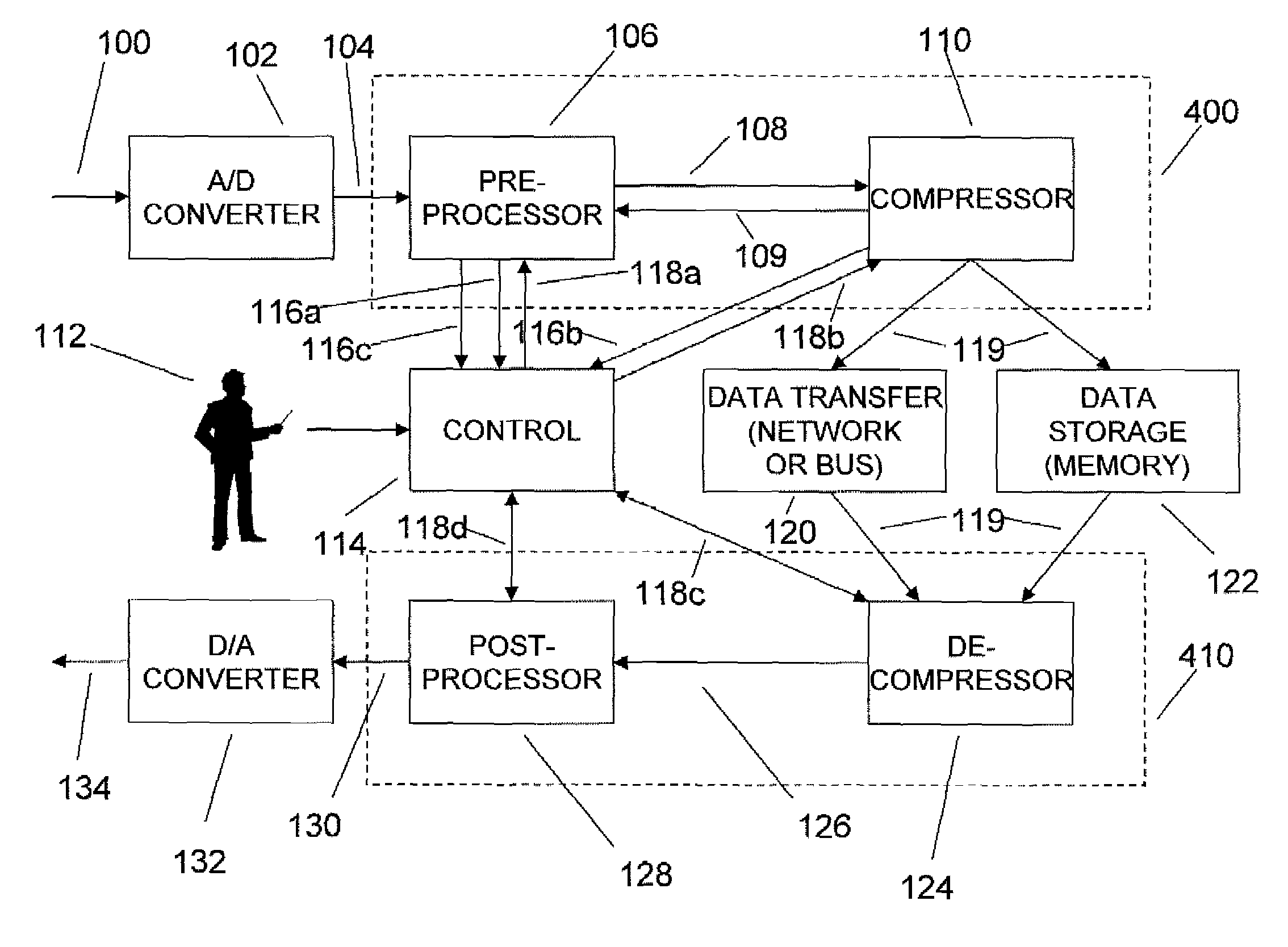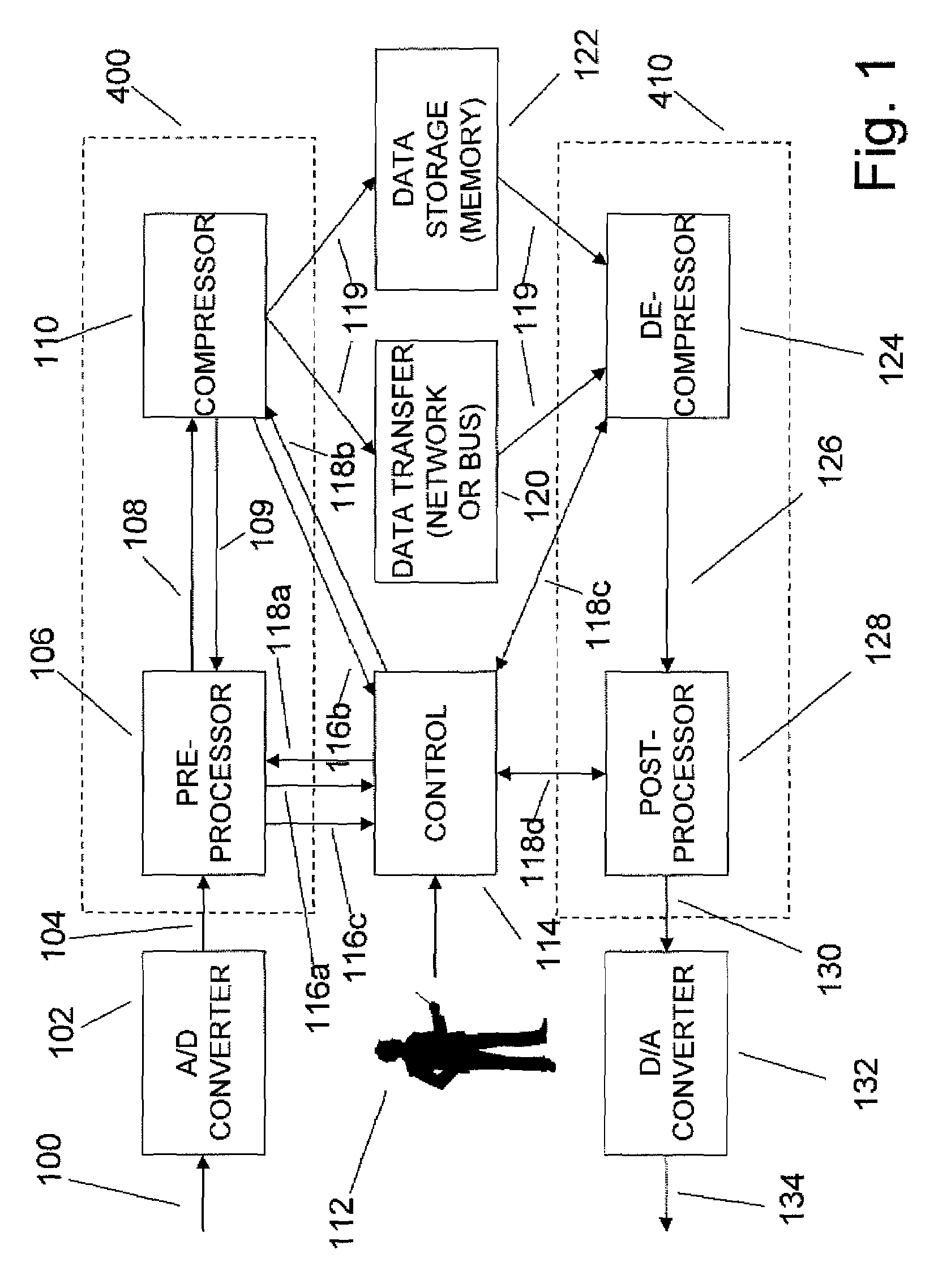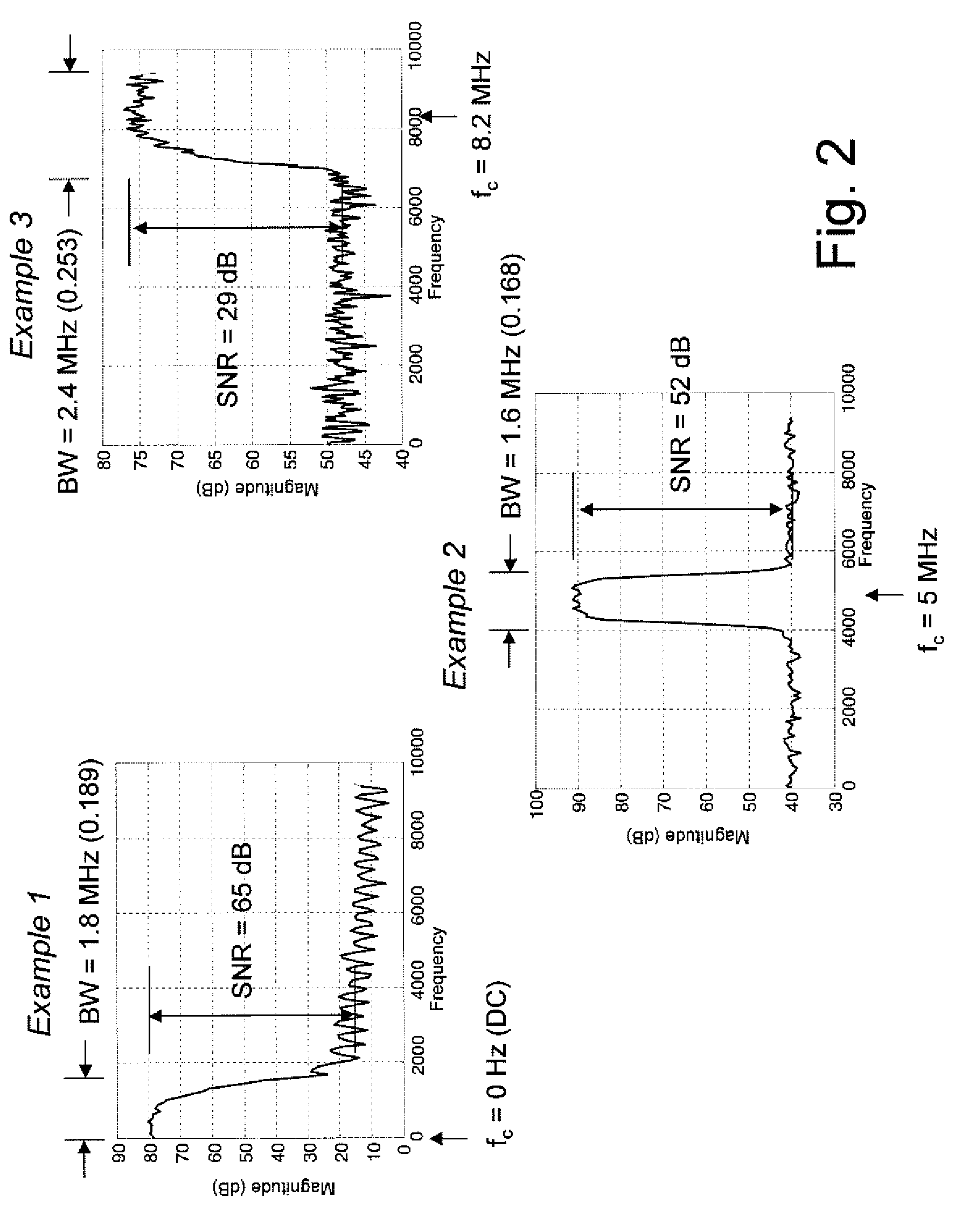Sampled analog signals consume significant bandwidth and memory during acquisition,
processing, and storage, especially when such signals are stored in a storage medium for later retrieval and analysis.
For details, we include the following excerpt from [2]:There are two limitations when using MPEG to make scientific
visualization movies, which are picture rates and image sizes.
These limitations are due to the fact that MPEG was developed to meet certain requirements and standards found in the television and motion picture industry.
Image sizes also have limitations for best movie playback results.
Another factor that prevents MPEG movies to be played at reasonable speeds in
software is
system load.
The higher the load, the slower the playback speed.
However, many sampled analog signals do not contain speech, audio, images, or video.
If the
analog signal is sampled at a rate lower than fs / 2, an undesirable phenomenon called
aliasing occurs.
Aliasing is undesirable because if it is allowed to occur, the same sample
stream can represent more than one signal.
When
aliasing occurs, the frequency source of the signal energy is ambiguous, and the signal is therefore effectively useless.
One reason for a lack of compression solutions for the general class of high-speed analog signals is the perceived difficulty of compressing them.
If these signal characteristics are not met prior art compression results will suffer.
Because existing speech, audio, image, and video compression techniques have made the assumptions listed above about the signals they are compressing, prior art compression techniques are not effective if the bandwidth, SNR, and
center frequency of the signal to be compressed vary over time.
The distortions minimized by speech and audio compression algorithms are not the appropriate or applicable
distortion metrics for judging compression quality if the input signal is not audible, i.e. was not obtained from an
analog signal with maximum frequency at or below 20 kHz.
The distortions minimized by image and video compression algorithms are not appropriate or applicable
distortion metrics for judging compression quality if the input signal is not visual, i.e. was not obtained from an input
analog signal that represents a still or a moving image.
If the input analog signal belongs to another signal class, the compression technique may make inappropriate assumptions that degrade the resulting signal after a compress-decompress cycle.
A speech compression
algorithm does not achieve acceptable compression results on an image.
Similarly, a video compression
algorithm does not achieve acceptable compression results on an
audio signal.
For this reason, speech and audio compression algorithms are not appropriate for compressing a communications signal, a geophysical signal, or an
oscilloscope waveform, because the assumptions made by the
compression method (frequency limits, non-uniform frequency sensitivity, and frequency and temporal masking) are not applicable to such a communications signal.
Thus the many application-specific compression solutions developed for speech, audio, images, and vision, while valuable in those applications, are not effective for compressing a broad class of bandlimited, high-speed analog signals.
Lossy audio and video compression techniques typically require significant
signal processing effort to achieve their compression and decompression results.
For instance, the lossy MPEG video and audio compression algorithms often require special, expensive
signal processing hardware to compress or to decompress an MPEG
stream in real time at a high
quality level.
While decompression of lossy-compressed signals can sometimes be performed by a
personal computer's (PC)
central processing unit (CPU) without such special hardware, real-time lossy audio and video compression often requires special, expensive hardware support.
Using more than a few MHz to represent video or images would be a waste, since the human
visual system cannot perceive the additional pixels or the faster
frame rate.
Even if speech, audio, image, and video compression algorithms could effectively compress signals with wider bandwidths (and for which their assumptions about signal content were not intended), there is a fundamental complexity problem in applying such compression algorithms at higher sampling rates.
Clearly, processors with this many operations do not exist today, and even if they did exist, they would require prohibitive amounts of power and area to implement MP3 at this sampling rate.
Consequently, the cost of such processors would be prohibitive.
To summarize, the application of speech, audio, image, and video compression solutions to signals with significantly higher sampling rates is impractical and expensive, because such prior art compression solutions do not scale effectively and hence are too complex to be applied to signals with significantly higher sampling rates.
Applications exist where the approximations introduced by
lossy compression methods are unacceptable.
In audio applications, especially in the fields of
professional audio post-production and archiving, lossy audio compression techniques introduce unacceptable artifacts.
Algorithms that compress these kinds of files are of necessity lossless.
For these kinds of compression applications, even a single error in the re-creation of the original file from its compressed version would be catastrophic.
Lossless
data compression algorithms that reduce the storage required to represent the files
exploit the statistical characteristics present in such common computer files.
Unfortunately, the statistical properties of computer files differ significantly from those computer files that contain
digital audio or video.
For this reason, lossless
data compression algorithms designed for text, spreadsheet, or program files that are applied to sampled audio or video signals typically result in little or no reduction in storage.
Sampled data signals do contain redundancies, but existing lossless
data compression algorithms are not designed to detect or to
exploit the redundancies specific to such signals.
Another drawback of lossless data compression methods intended for typical computer files is that they are not designed to run in real time.
Even if acceptable compression ratios could be achieved on audio or video files by these
text compression methods, they would in all likelihood not run in real time as defined above.
To summarize, existing
lossy compression methods developed for signals that are intended for human listening or viewing suffer from the following drawbacks when applied to a broader class of
wideband, bandlimited sampled high-speed analog signals:they incorrectly use assumptions about signal characteristics that are not applicable,they cannot operate at increasingly fast sampling rates due to their complexity,they cannot operate effectively as the
center frequency, bandwidth, or
noise floor (SNR) of the input signal varies,they minimize
distortion metrics that reflect known limitations of human hearing and vision, but such metrics are not appropriate for non-audible, non-visual signals,they do not inform users when the distortions introduced during
lossy compression will be noticeable.
Therefore compressor 110 cannot effectively compress
noise or
noise-like components of sampled input signal 104.
Those skilled in the art will recognize that two analog signals can only be compared in relative terms, since the measurement of analog signals always involves some noise source, even if the only noise source is low-level thermal noise within the measurement or comparison device.
For a given signal, higher data rates allow lower (or zero) distortion, while lower data rates result in higher distortion.
However, because these signal types (speech, audio, images, and video) are nearly always
baseband or lowpass signals, the corresponding compression solutions for such signals are optimized, and in fact are often only effective, for lowpass signals.
If signals with bandpass or highpass characteristics were processed by such
baseband compression solutions, the results would be unsatisfactory.
Thus prior art compression methods do not provide satisfactory results (as expressed by the
compression ratio or by the perceived distortion) on bandpass and highpass signals.
Other sampled analog signals (such as
white noise) will not compress at all, because the signal varies unpredictably and thus has little or no redundancy.
For signals with non-DC carrier frequencies, prior art compression methods will not work very well because one of their fundamental assumptions (DC carrier frequency) is violated.
Unfortunately, the compression performance and distortion levels of prior art compression methods often depend upon having a clean, noise-free sampled input signal 104 available for compression.
Furthermore, many analog input signals not containing speech, audio, image, and video sources also contain unavoidable amounts of noise.
For example, geophysical signals with MHz bandwidths are acquired from sensors that are thousands of feet under the surface of the earth, where temperatures and pressures cause high levels of ambient noise to be captured along with any measurements from these sensors.
As a second example, a transmitted communications signal in a
wireless system may be severely attenuated at a
receiver antenna.
Unless a
preprocessor (such as that used by the present invention) determines the
noise floor of the input signal and adjusts for the
noise floor level, a follow-on input signal compressor will compress significant amounts of noise and thus will suffer from degraded performance: lower
lossless compression ratios and higher distortion levels after compression.
Those skilled in the art of
data conversion will also recognize the difficulty of maintaining
dynamic range (bits per sample) as the sample rate is increased.
Data converters with 16 or more bits per sample are common and relatively inexpensive at sampling rates of 1 Msamp / sec or lower, while data converters with more than 8 bits per sample are rare and relatively expensive at sampling rates of 1 Gsamp / sec or higher.
As mentioned earlier, the
noise component of sampled data signals cannot be compressed.
However, the fractional LSB
noise floor removal technique requires a multiplier, which in
hardware implementations is more complex (and thus more expensive in both
silicon area and cost) than a simple right-shift operation, which is implemented in
silicon as wiring between two registers.
Impedance mismatches between the analog signal and the data converter
Because data converter manufacturers cannot control the environment in which their converters are used, and because these environments often changes dynamically over time, the noise floor of systems employing data converters is also often dynamic.
In the context of compression, a varying noise floor is undesirable because
compression system designers often assume that the noise floor of the signal to be compressed is stable and at a level below the LSB of the data converter that provides sampled input signal 104 to compressor 110.
In many instances, system designers (such as those who
design data acquisition systems) never know the nature of the environment in which their equipment is used, nor are users of such
data acquisition electronics always aware of their (static or dynamic) noise floor levels.
However, since the LSBs that were removed also correspond to values below the noise floor, the resulting samples will not be noticed, as they represented noise, not signal.
Should we fail to observe this restriction, we will
alias some of our desired signal components and thus distort our signal.
Practically, complex tone generators can generate either an upconversion or a downconversion tone.
For all of the reasons reviewed in Section 2 (Prior Art Discussion), the widely known compression algorithms developed for speech, audio, image, and video compression are inappropriate for
oscilloscope applications, and indeed could not be performed in real time at
oscilloscope digitization rates.
Although pattern generator memory can greatly increase the
effective length of periodic waveforms generated by the AWG, such an AWG still cannot generate unique waveforms longer than the waveform storage memory (64000, in the previous example).
It must be emphasized that such a choice is not available on today's
digital storage scopes.
Such high sampling rates are causing design difficulties to users of such A / D converters, who must expend ever-increasing design time to ensure that the A / D converter output signals can be processed by other integrated circuits.
The relationship between price and
access time is not always linear, but it is almost always monotonic: faster storage is more expensive than slower storage.
Because compression systems reduce the amount of data, this reduction also affects the
clock rate.
Because the amount of redundancy in sampled data signals varies over time, the output rate of a lossless
compression system also varies over time.
Those skilled in the art will recognize that not all algorithms are effectively implemented using
parallel processing.
 Login to View More
Login to View More  Login to View More
Login to View More 


